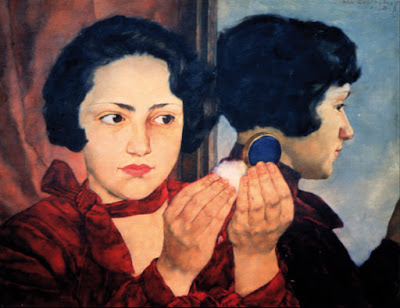It has been a while since my last Favorite Artists post so here is a tribute to one of the great artists of the last century.
Andrew Wyeth is actually likely to be remembered as one of the tiny handful of artists who were the greatest ever.
 |
| "Braids," egg tempera, 19x20, 1977 |
Mr. Wyeth is certainly the contemporary favorite artist of many Americans. Despite his adherence to making realist art throughout his lifetime and despite sometimes unfavorable reviews for much of it, his popularity as an artist continues in our own century. Indeed, his reputation has resurged and his popularity has increased. There was even a PBS
American Masters episode not long ago dealing with his luminous career. The video can be viewed at the link above. It provides new comments from people within his circle, including Helga Testorff, whose secret modeling for him was an enormously titillating story in the last decades of the 20th century.
Mr. Wyeth remains a personal favorite for a lot of reasons and although I've previously posted a bit about his work, he deserves an entry in this Favorite Artists series. Here are a few of my favorites from among his vast oeuvre and why.
 |
| "Pennsylvania Landscape," egg tempera, 35x47, 1942 |
Wyeth was a consummate draftsman (see his portrait of Helga, above, "Braids"). At his best, Andrew Wyeth was every bit the equal of masters of the past, from Michelangelo on down to Ingres. Whether his subject was a comely young woman or a dead bird, Mr. Wyeth was able to draw it believably, often from memory, according to recent quotes. Whether he drew from life or memory, his precision is on abundant display in virtually all of his works from the 1940s onward. You can see his keen eye and hand in "Pennsylvania Landscape," for example, which dates from early in his adoption of his signature medium, egg tempera.
 |
| "Pentecost," egg tempera, about 20x24, 1989 |
Although critics were commonly nonplussed by his restrained palette, he made color work toward his aims rather than overwhelm them. In "Pennsylvania Landscape" and in later works like"Pentecost" (1989) he displays his mastery almost casually. He had an eye for color in his world and in his work, and he made it work well. In any number of his works his colors are generally low in chroma and often low in value, but when he includes a color note it falls perfectly within the composition.
Besides draftsmanship and color it is also fascinating to explore Wyeth compositions, as one can in the two landscapes above. In each there is a near land-mass, distant detail to the left, a far landmass, and sky in the distance. In the early work, a huge sycamore in the foreground splays against the sky while in the later one nets fastened to a series of poles billow in the foreground. The compositions approach abstraction but give realistic depth and interest.
 |
| "The Carry," egg tempera, 24x48, 2002 |
As he aged, the painter's work became more abstract without losing its realistic foundations. In the very late tempera "The Carry" (2002) mastery is again evident in the use of color and composition. A carry is a portage, a shallow place or a waterfall where a boat can't float and must be carried. In this tempera painting, there is a waterfall that is dark in the foreground then blue and yellow as the water crosses from shadow into sunlight, then a different, paler blue in the distance. The flowing, serpentine abstraction of the stream, coupled with his characteristic color restraint, make for an enormously satisfying realist painting. But under it all his color juxtapositions in the middle ground simply sing. The foamy water as it flows over the near portion of the crescent falls provides the viewer with opportunities to explore the artist's consummate brush strokes and knowledge of perspective while the more distant and dark woods provide a break point as the stream flows past them and into the pale distance. This particular painting was included as one of 12 in a
United States Postal Service commemorative set last year.
 |
| "Snow Hill," egg tempera, 33x46, 1989 |
One final word about Mr. Wyeth's subject matter. On the surface it is often rural in setting and realist in execution. In his early years he was wrongly hailed as a surrealist, but he never was. Critics in the late 20th century often felt that his work was emotionally flat. But his work had emotional depth for it's creator, without doubt. Sometimes a painting was triggered by the loss of a friend, or by other events that carried weight for him. In "Snow Hill," a group of figures dances (incongruously) around a maypole at the top of a snowy hill. In the distance is the Kuerner farm, one of his recurrent motifs. The figures included are all important in his work up to that time. Mr. Wyeth commented that it wasn't simply a pleasant picture but actually a vengeful celebration of his death by all of his familiar characters. There are six figures in all but seven ribbons, the empty seventh reserved for the artist himself. Mr. Wyeth painted this in celebration of his 70th birthday, hence the seven ribbons, one for each decade. The ribbon to Helga Testorff (far right) is alight with a beam of sunshine at the top, but all the others are dark--she was still alive at the time. The landscape is almost completely empty, although the area around the hill--Chadds Ford--is wooded, perhaps an allusion to the end of life.
Although he was often dismissed by art critics, Mr. Wyeth trod his own path with a mighty talent and a keen eye. He is bound to be remembered for as long as painting is valued.
---
Previously on this blog:
Favorite Artists
Favorite Artists 2
Favorite Artists 3
Favorite Artists 4
Andrew Wyeth






























